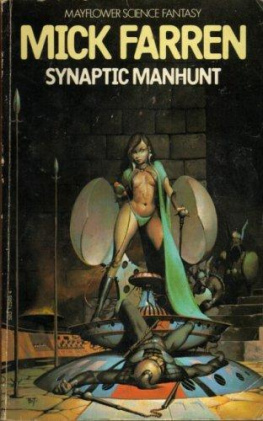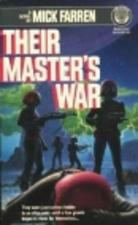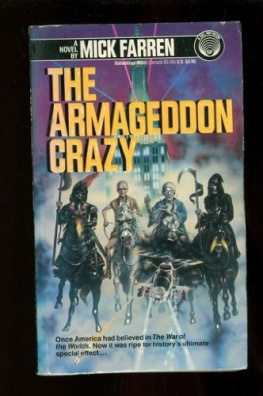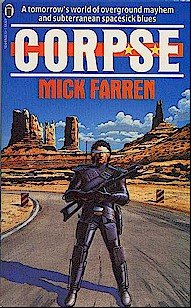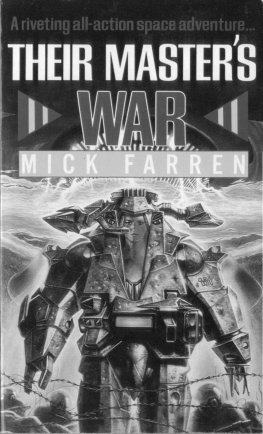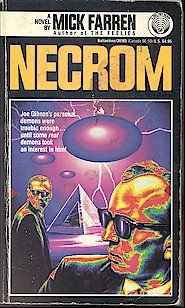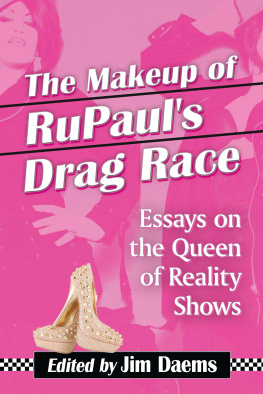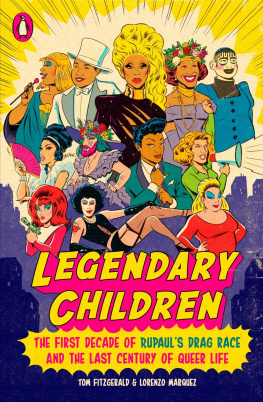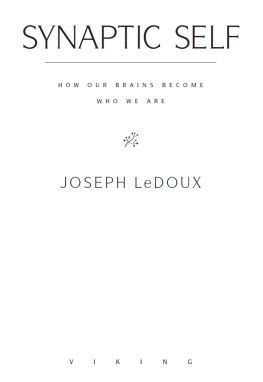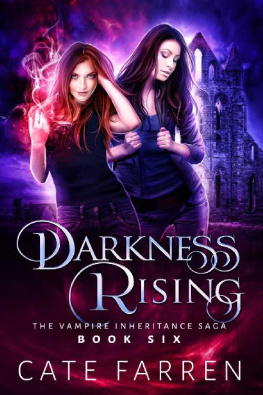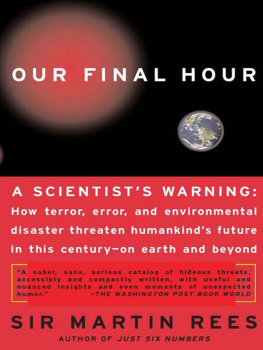Farren - Synaptic Manhunt
Here you can read online Farren - Synaptic Manhunt full text of the book (entire story) in english for free. Download pdf and epub, get meaning, cover and reviews about this ebook. City: London, year: 1976;2013, publisher: Mayflower;Ink Monkey Books Limited, genre: Detective and thriller. Description of the work, (preface) as well as reviews are available. Best literature library LitArk.com created for fans of good reading and offers a wide selection of genres:
Romance novel
Science fiction
Adventure
Detective
Science
History
Home and family
Prose
Art
Politics
Computer
Non-fiction
Religion
Business
Children
Humor
Choose a favorite category and find really read worthwhile books. Enjoy immersion in the world of imagination, feel the emotions of the characters or learn something new for yourself, make an fascinating discovery.
- Book:Synaptic Manhunt
- Author:
- Publisher:Mayflower;Ink Monkey Books Limited
- Genre:
- Year:1976;2013
- City:London
- Rating:3 / 5
- Favourites:Add to favourites
- Your mark:
- 60
- 1
- 2
- 3
- 4
- 5
Synaptic Manhunt: summary, description and annotation
We offer to read an annotation, description, summary or preface (depends on what the author of the book "Synaptic Manhunt" wrote himself). If you haven't found the necessary information about the book — write in the comments, we will try to find it.
Synaptic Manhunt — read online for free the complete book (whole text) full work
Below is the text of the book, divided by pages. System saving the place of the last page read, allows you to conveniently read the book "Synaptic Manhunt" online for free, without having to search again every time where you left off. Put a bookmark, and you can go to the page where you finished reading at any time.
Font size:
Interval:
Bookmark:
MICK FARREN is a product of St. Martin's
School of Art, Phun City, IT, Nasty Tales and
an Old Bailey obscenity trial. He now writes
full-time and has had three previous novels
published. Synaptic Manhunt is the second
in a stunning new Science Fantasy trilogy.
Also by Mick Farren
in Mayflower Books
Synaptic Manhunt
Mick Farren
Mayflower
Granada Publishing Limited
First published in 1976 by Mayflower Books Ltd
Frogmore, St Albans, Herts AL2 2NF
A Mayflower Original
Copyright Mick Farren 1976
Made and printed in Great Britain by
Richard Clay (The Chaucer Press) Ltd
Bungay, Suffolk
Set in Linotype Plantin
This book is sold subject to the condition that it
shall not, by way of trade or otherwise, be lent,
re-sold, hired out or otherwise circulated
without the publisher's prior consent in any
form of binding or cover other than that in
which it is published and without a similar
condition including this condition being imposed
on the subsequent purchaser.
This book is published at a net price and is
supplied subject to the Publishers Association
Standard Conditions of Sale registered under
the Restrictive Trade Practices Act, 1956.
The total silence was only broken by the soft slow dripping of the water clock. The high, narrow room was lit by a solitary candle, and far corners of the dull stone walls were hidden in darkness. The room was bare and austere, but it had an atmosphere of absolute calm. There was no furniture apart from the iron stand that held the candle, the glass water clock on its wooden bench and a small raised dais in the very centre of the room. The dais was covered with a coarse-weave straw mat. A figure sat on the dais. It was shrouded in a plain black robe, its legs were crossed and its hands lay in its lap with the fingers interlaced in a complicated pattern. Although the candle was placed directly in front of the figure, its head was sunk between the shoulders in such a way that the face was obscured by shadow. From the width of the shoulders, and the supple, powerful hands, which were clearly illuminated by the candle, it was obvious that the figure was that of a male.
The name of the male was Jeb Stuart Ho, although, right at that moment in time, Jeb Stuart Ho hardly existed. His pulse was down to the absolute minimum that would sustain life. His body temperature had reduced by half and his lungs hardly stirred. Except for his upright, crosslegged posture, the lay observer would have assumed him to be dead. But Jeb Stuart Ho was alive. The physical state that he was in was self-induced. He would, however, certainly die within a com-paratively short time unless roused by some outside force. The art of terminal meditation was one that was slowly and pain-fully learned. Once the individual had reached that state there was no release from it except a sharp tap on the shoulder by another who was practised in the same skills.
Being so close to death and so dependent on outside help might have terrified any normal person. Jeb Stuart Ho was beyond terror. He knew nothing, although, at the same time, according to his philosophy, he knew everything. He was in a world that few people outside the temple ever visited. It was beyond the scope of language, beyond emotion and far past the reach of sight, taste, smell or touch. A door at the far end of the room opened softly. Another man in a black robe entered and walked silently towards Jeb Stuart Ho on sandalled feet. He halted in front of the seated figure, and almost ritualistically took a short polished stick of hard dark wood out of his sleeve. He paused for a moment, and then struck a swift, light blow on Jeb Stuart Ho's shoul-der. He stepped back and waited. At first, nothing happened, and then the still figure made a soft noise. Jeb Stuart Ho was drawing air into his lungs. At first it was tiny amounts and his body scarcely moved. Then his chest began gradually to rise and fall as he sucked in deeper breaths. Finally, he completely filled his lungs, and began to raise his head. The mind of Jeb Stuart Ho seemed to float upwards. First into a place where it was warm, then sound invaded the comfortable area, the sighing of his blood as it slowly began to circulate through his veins. The pulse of his heart started, up, softly and in wide-spaced intervals at first, but then quickening and getting louder. His sense of touch came alive. He could feel the pressure of his body on the coarse mat beneath him. He was aware of the texture of the robe that covered his body. He knew that his mouth was dry and that his stomach would shortly begin to demand food. He rose towards the light. He opened his eyes, and an image of the dim room rushed in with dazzling brilliance. Jeb Stuart Ho silently regarded the man standing in front of him. He was slimmer and younger than Ho, little more than a boy. His face was smooth and expressionless. Jeb Stuart Ho matched this first rush of sensation, which came after the deep meditation, with his memory. The boy was Nah Duc West. His pupil, his servant in the temple and his lover.
No spoken greeting was necessary between the two men. Ho simply stretched out his hand and touched the younger man. Then he rose to his feet and walked purposefully out of the room. The young man followed him.
The door of the meditation room led out into a high-ceilinged corridor. It was made from the same dull black stone as the walls of the room. The corridor was illuminated by glowing spheres set in the walls at regular intervals.
They walked down the perfectly straight corridor for some minutes until they came to a pair of double doors, decorated with elaborate carvings and flanked by two more figures in black robes. They appeared to recognize Jeb Stuart Ho, and stepped back, pushing the doors open. Once again, there was a trace of ritual in their action. Beyond the carved doors was a huge, brightly lit circular room. It had a domed ceiling that glowed with the same steady light as the globes.
The room was a hive of activity. Along one section of the curved stone wall, a line of black-robed figures sat on high stools, bent over desks and drawing tables that were littered with charts, graphs, columns of figures and computer print-outs. Another long section of wall was taken up by a huge display screen where coloured lights and curved lines slowly shifted position. On a vast plan table in the centre of the room, more black-clothed figures moved transparent overlays with lines and points of colour drawn on them, similar to those on the display screen.
The most intense activity was centred round another sec-tion of the curved wall that took up nearly a third of the total circumference. The section was covered with a soft translucent ribbed material. The ribs ran vertically from the floor to the start of the domed ceiling. It bulged out slightly, and occasionally undulated. Behind the material there was a soft green glow that also moved and shifted. Some patches grew brighter, and others dimmed. The crowd of black robes that clustered round it were stroking the surface of the soft wall section with their hands. Their palms and fingertips moved in definite, precise patterns. Occasionally one of them would carefully insert a long fine silver needle into the material. The operations appeared to involve a high degree of skill.
The domed room was the heart of the entire temple. It was here that Jeb Stuart Ho's brothers carried on the eternal work. It was here that they monitored the progress of the various cultures that flourished in the sundered world that remained after the breakdown.
Over the centuries since the natural laws had ceased to be consistent and human life had clung to areas where artifi-cial stasis could be generated, the brothers had worked single-mindedly on their never-ending task. They had observed and recorded the smallest event in the hundred thousand com-munities that survived in among the grey nothings. The most insignificant happening was plotted into their charts and in-cluded in their calculations. There was a saying among the brothers that even the fall of a sparrow was worthy of inclu-sion in their graphs, the graphs that charted the passage of past events and from which the brothers made their predictions for the future.
Next pageFont size:
Interval:
Bookmark:
Similar books «Synaptic Manhunt»
Look at similar books to Synaptic Manhunt. We have selected literature similar in name and meaning in the hope of providing readers with more options to find new, interesting, not yet read works.
Discussion, reviews of the book Synaptic Manhunt and just readers' own opinions. Leave your comments, write what you think about the work, its meaning or the main characters. Specify what exactly you liked and what you didn't like, and why you think so.

